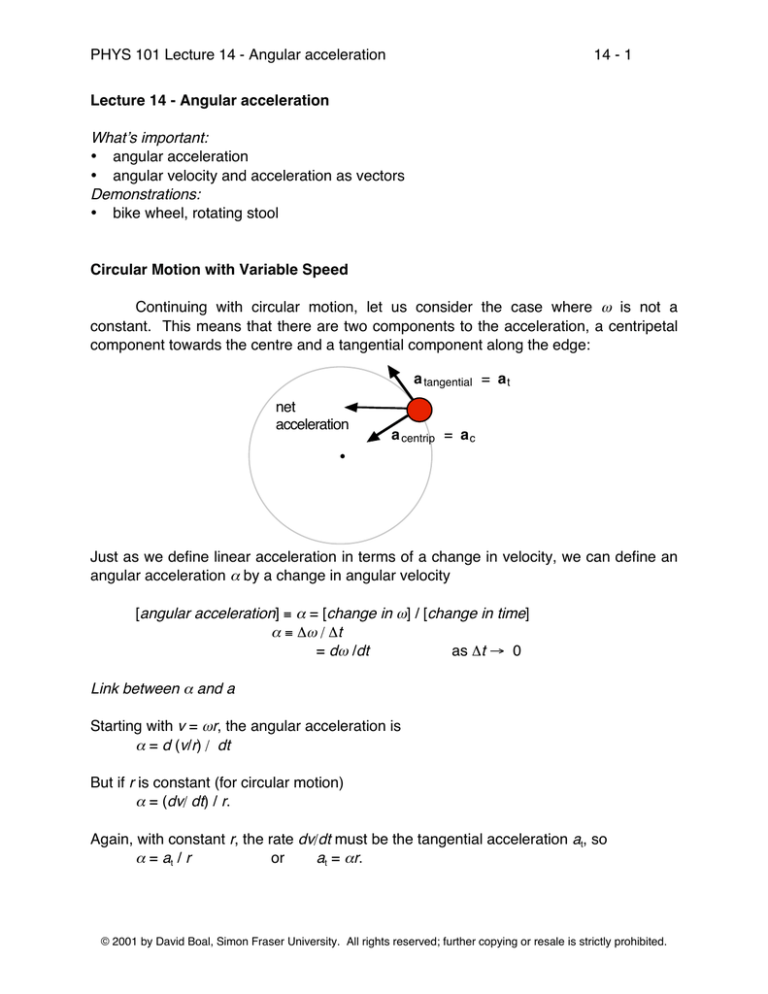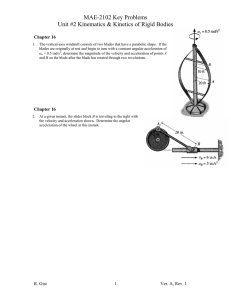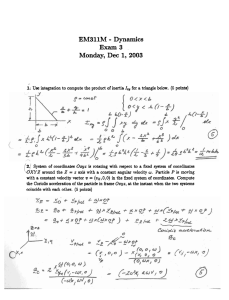
PHYS 101 Lecture 14 - Angular acceleration
14 - 1
Lecture 14 - Angular acceleration
What’s important:
• angular acceleration
• angular velocity and acceleration as vectors
Demonstrations:
• bike wheel, rotating stool
Circular Motion with Variable Speed
Continuing with circular motion, let us consider the case where ω is not a
constant. This means that there are two components to the acceleration, a centripetal
component towards the centre and a tangential component along the edge:
a tangential = a t
net
acceleration
a centrip = a c
•
Just as we define linear acceleration in terms of a change in velocity, we can define an
angular acceleration α by a change in angular velocity
[angular acceleration] ≡ α = [change in ω] / [change in time]
α ≡ Δω / Δt
= dω /dt
as Δt → 0
Link between α and a
Starting with v = ωr, the angular acceleration is
α = d (v/r) / dt
But if r is constant (for circular motion)
α = (dv/ dt) / r.
Again, with constant r, the rate dv/dt must be the tangential acceleration at, so
α = at / r
or
at = αr.
© 2001 by David Boal, Simon Fraser University. All rights reserved; further copying or resale is strictly prohibited.
PHYS 101 Lecture 14 - Angular acceleration
14 - 2
Thus, we have the parallel equations (for constant radius)
arc length
= θr
speed
= ωr
tangential acceleration
= αr
Thus, we expect to find relations amongst θ, ω, α and t just as with x, v, a and t.
Suppose we have uniform angular acceleration
angular
acceleration
!
take
the
area
t
angular frequency
angle
"
#
! area = ( " - "o)t/2
"o
area
! area =
t
"ot
t
(assume # = 0 at t = 0)
The area of the angular acceleration graph gives a linear time dependence for the
angular velocity:
ωf = ωo + αt
---> αt = ωf - ωo
The area of the angular velocity graph gives a quadratic time dependence for the angle:
θ = ωot + (ωf - ωo)t / 2
or
θ = ωot + αt2/2.
Finally, an alternate expression for the angle which does not explicitly show the time
dependence can be found by rearranging the above expressions:
θ = (ωf2 - ωo2) / 2α.
© 2001 by David Boal, Simon Fraser University. All rights reserved; further copying or resale is strictly prohibited.
PHYS 101 Lecture 14 - Angular acceleration
14 - 3
Example
A carousel, starting from rest, attains a frequency of one revolution every 5 sec after 10
sec. Assuming uniform acceleration, what is the angular acceleration? If the carousel
is 10 m in diameter, what is at after 10 sec?
Solution
After 10 seconds,
T=5s
f = 1/T = 1/5 s-1
We can use ω = ωo + αt
ωo = 0
plus ω = 2π/5 s-1 (at t = 10 s)
2π/5 = 0 + 10α.
ω = 2πf = 2π/5 rad/sec
gives
The angular acceleration is then
α = 2π / (5 • 10) = π/25 radians/sec2.
The tangential acceleration at (time-independent magnitude if α = const), can be found
from the angular acceleration:
at = αr = (π/25) • 5 = π/5 m/s2 (or 0.63 m/s2)
NOTE: even though at is constant, atot is not constant, since ac changes as the carousel
accelerates.
© 2001 by David Boal, Simon Fraser University. All rights reserved; further copying or resale is strictly prohibited.




